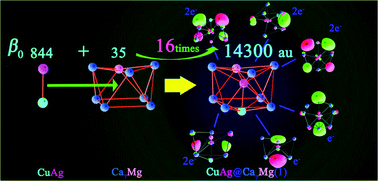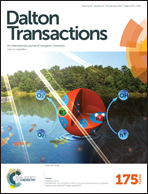All-metal electride molecules CuAg@Ca7M (M = Be, Mg, and Ca) with multi-excess electrons and all-metal polyanions: molecular structures and bonding modes as well as large infrared nonlinear optical responses†
Abstract
All-metal electride molecules, CuAg@Ca7M (M = Be, Mg and Ca), have been designed and researched in theory for the first time. In these molecules, a pull–push electron relay occurs. Unusually, the all-metal polyanions of fourfold negatively charged [Cu–Ag–Be/Mg]4− and [Cu–Ag]4− with 4 extra electrons gained from Ca atoms push the remaining valence electrons of the Ca atoms forming the multi-excess electrons (Ne = 10/12). Therefore, these molecules can be described as salt-like [(Ca2+)7(CuAgM)4−] + 10e− (M = Be and Mg) and [(Ca2+)8(CuAg)4−] + 12e−. In these salt-like molecules, there are extraordinary covalent bonding modes, which include 2c–2e/3c–2e σ-bonding in the polyanions and the Ca2+ cations sharing the diffuse multi-excess electrons. For an intriguing nonlinear optical (NLO) response, these all-metal electride molecules display large electronic first hyperpolarizabilities (β0), thus a new class of NLO molecules, all-metal electride NLO molecules, emerge. Moreover, it is also found that manipulating the atomic number and position of M is a new strategy to enhance β0. As a result, CuAg@Ca7Mg(1) exhibits a considerable β0 (1.43 × 104 au), which is 16 times the β0 sum of two isolated CuAg and Ca7Mg(1) subunits, and this deeply reveals the fundamental origin of the considerable β0, namely, the multi-excess electrons generated by the subunit interaction. These all-metal electride molecules have the infrared (IR) transparent region of 1.3–6 μm, and hence are new IR NLO molecules. In addition the electronic contribution, β0, the large effects of vibrations on the static first hyperpolarizabilities of these all-metal electride molecules are also estimated. Thus, this study opens the new research field of all-metal electride IR NLO molecules.


 Please wait while we load your content...
Please wait while we load your content...